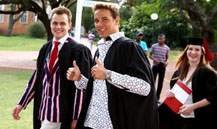 |
Photo: Hannes Pieterse
20 September 2012 |
The guest list for the Spring Graduation ceremony of the University of the Free State included an Olympic gold medallist, a former Miss South Africa finalist and the Prime Minister of a neigbouring country.
The new graduates could draw inspiration from Olympic swimming champion Chad le Clos, who was the guest speaker at the event. Also attending was the Prime Minister of Lesotho, the Honourable Thomas Thabane, who came to watch his grandson graduating from Kovsies. Sharing a stage with Le Clos was Rolene Strauss, a medical student, who was among the top five contestants at last year’s Miss South Africa competition.
Le Clos, who became a national hero in July when he won a gold medal in the 200 m butterfly at the Olympic Games by beating American swimming legend Michael Phelps, told new graduates to strive for the impossible. Giving them insight into his remarkable achievement, Le Clos told them nobody had expected him to beat Michael Phelps. “Even I thought it was impossible to achieve. Always have a goal and work towards it,” he told them and said his ambition was to build up swimming in South Africa. Le Clos said he hoped that by 2016 there would be more swimmers making South Africa proud.
Prof. Jonathan Jansen, Vice-Chancellor and Rector of the university, delivered an Olympic-inspired message. Quoting the motto of the modern Olympic Games, ‘faster, higher and stronger’, Prof. Jansen told the new graduates that they had to be better than those who came before them. “I expect my students in a troubled country to learn how to be different, faster, higher and stronger. Faster means efficiency; it means to be responsive to those in need."
Drawing lessons for the country from Le Clos' victory, Dr Khotso Mokhele, Chancellor of the University, told the graduates to choose optimism. Referring to the Marikana mine tragedy, Dr Mokhele said the country was far from taking the last stroke. “Even if it looks as if the curtain is down; remember that final stroke of Chad le Clos and how the great Michael Phelps was defeated.”